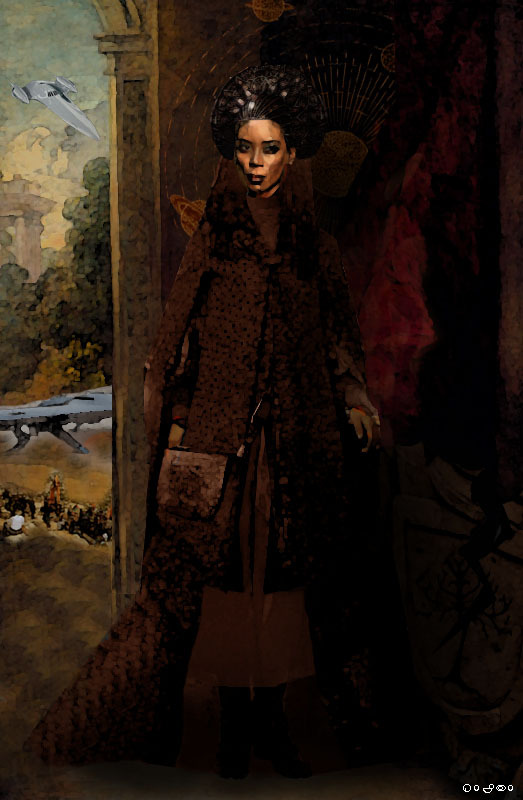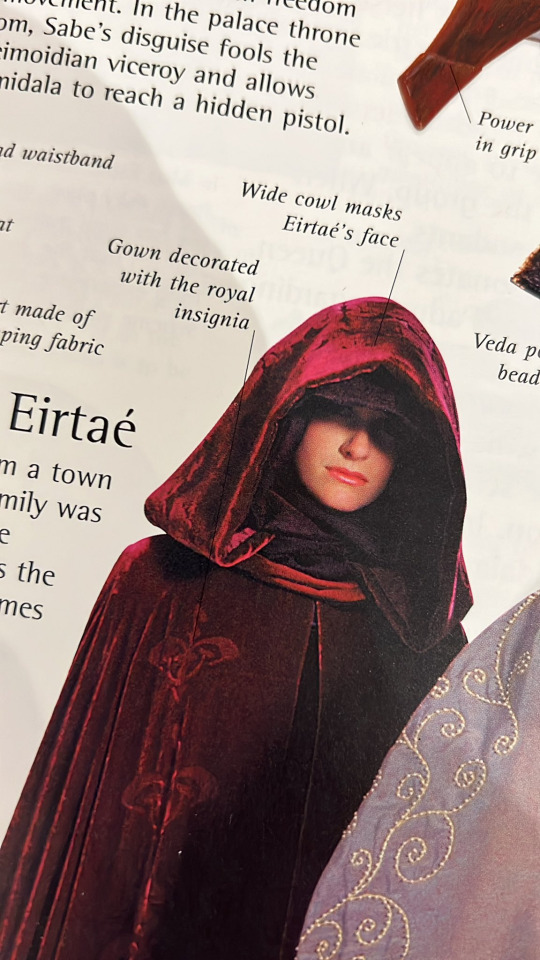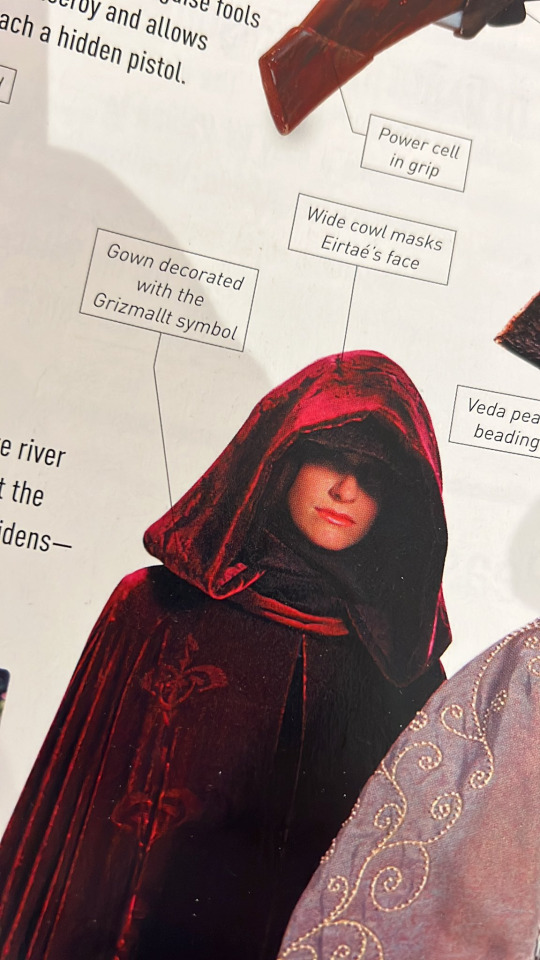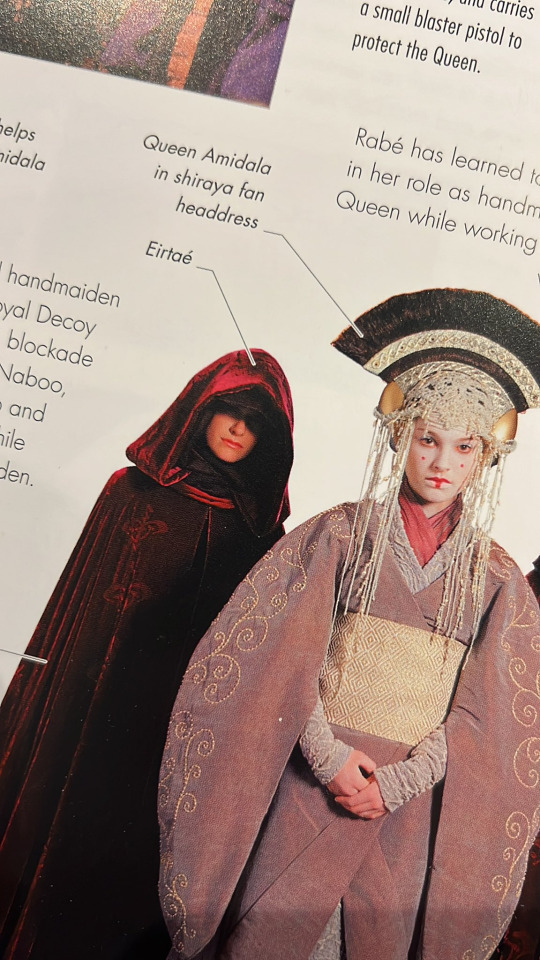#Grizmallt symbol
Explore tagged Tumblr posts
Text
The Children of Naboo Celebrate

STAR WARS EPISODE I: The Phantom Menace 02:09:05
The young Naboo girl in pink seen celebrating here was also shown behind Anakin on the steps of the Royal Palace in a previous shot.
Also the blue and purple flag with a gold starburst and stripe through the center - could it be the flag of Naboo? The flag of Theed?
Hard to tell completely - but I think it looks like this:

#Star Wars#Episode I#The Phantom Menace#Naboo#Theed#Palace Plaza#Freedom Day#victory parade#unidentified flag#Battle of Naboo#Otoh Gunga#Theed Music Hall#Coliseum Plaza#unidentified Naboo#zoorif feather#Grizmallt symbol#Royal House of Naboo
4 notes
·
View notes
Text

The First Queen of Naboo (Legends)
A female of the Human species was anointed the first Queen of Naboo more than three millennia before the Invasion of Naboo in 32 BBY. She was one of the Human colonists who had fled a civil war on the Core World of Grizmallt and established a new civilization on the planet Naboo, a green haven located on the borders of the Outer Rim Territories. On the painting, we can see settlers on the left as they land in a Naboo-Like ships. Also, behind the Queen we can see a tapestry with a solar system indicating that she was an explorer.
While her people was engaged in bloody conflict with the native Gungans, that woman was chosen to lead the colonists, who took the name of their new homeworld and became known as "the Naboo." Although she accepted both the title and the function of Queen, that woman refused to be the founder of a hereditary succession line. (It is symbolized by a broken crest with symbol of a tree on the right.) Instead, the newly elected Queen decreed that her successor would be selected based on their merits only. This started a tradition of meritocratic democracy on Naboo, which would still be used millennia later. However, the constitution of Naboo had a provision that allowed the monarchy to become hereditary for a worthy dynasty, and this happened at least once in history.
Unfortunately, not many information about the Queen survived to our times. We do not know her name or how she looked like. The artist decided to choose for her a simpler costume in shape and tone, similar which was wore by Naboo Senators, to mark that Naboo just starts to build their rich civilisation. The Lady also has a travelling bag indicating that she was a colonist.
On Queen's head we can see a Naboo crest headdress and a Naboo royal crest on the red curtain, underlining the importance of the lady. She indeed was the first ruler of Naboo.
Queen Amidala | Queen Jamilia | Queen Neeyutnee | Queen Apailana | Sosha Soruna | Queen Réillata | Queen Mairayni | Queen Sanandrassa | Queen Kylantha | Sabé - The Decoy Queen | Queen Yram | Queen Dalné | The Gungan-Naboo War Queen of Naboo | Queen of Naboo from the New Republic | King Jafan I Star Tours Queen of Naboo | King Veruna | The First Queen of Naboo | King Tapalo | Queen Ameé | Queen Ekay | King Jafan III | The Queen of beaded emblems | King Narmlé | Queen of Naboo from High Republic | Queen Elsinoré den Tasia
#star wars paintings | SW Paintings
#star wars paintings#star wars painting style#star wars#naboo queen#queen of naboo#naboo#naboo culture#first queen of naboo#unknown naboo queen#unidentified naboo queen#for 10th of sep there will be king bon tapalo he ruled just before veruna
21 notes
·
View notes
Photo



The fireworks and holographic display as seen in the episode "Crisis on Naboo" was meant to describe the history of Naboo. Images (from left to right) symbolize the crash of the Grizmallt colony ship on Naboo, Kwilaan's discovery of the world, and a nomadic tribe venturing into the Gallo mountains.
The second image show the nomadic tribe arriving at the Dee'ja peak, settling there and developing a farming community on that land. The next image shows the growth of Theed.
Also mixed into the fireworks display is a Republic cog, and yellow receding text that resembles the opening scrolling text that starts off the Star Wars movies.
Illustration by Tara Rueping.
26 notes
·
View notes
Text
The Religious Practices of Naboo
@lurkingcrow @jahaliel @calyssmarviss @albaparthenicevelut @misslearn @darthplodder @whoeverlikesthispretentiousshit
PART I
Two Faiths of Naboo
Like in many other worlds of the Republic, Naboo hosts various temples and shrines brought in by people from other worlds. Among the bounty of worshippers, one may find members of the Jedi laity1), followers of Alderaanian Star Deity or the Cult of Eternal Dance from Ryloth. But those are imported faiths; a phenomenon that occurred on Naboo only during the last centuries after the world that was once isolated from the rest of the galaxy joined the Republic.
It is known that there are two systems of belief that are native to the Naboo people.2) Daryatari, otherwise known as the ancestor veneration, and Hasyarvayadi, the worship of, for the lack of a better term, spirits. While Naboo are not the only people who reveres their forefathers, the overall manner and myths surrounding the practice tie it closely to their identity as a distinct ethnic group. Moreover, the practice of Daryatari is often explained as a vital part of the worship of Three Fates in Hasyarvayadi.
To understand truly what the people of Naboo believe and why without exploring their history first would be difficult. Therefore, let us delve into the past of one of the Republic’s most unique human cultures. The culture that speaks to us about the ways of life eras old.
PART II
The One, The Five and The Seven – The History
The annals speak about a long-lasting strife on the planet of Grizmallt that eventually resulted in a bloody revolution, almost costing the reigning monarch, Queen Elsinoré, her throne and her life. A massive exodus followed soon afterwards, marking a tragic milestone of Grizmalltian history. One of the exiled was the scout prince Kwilaan.
The commonly accepted story of his and his household’s journey unfortunately cannot be confirmed since during the revolution a lot of data storages were destroyed and the refugees had more pressing issues on their hands rather than recording the events.
Nevertheless, the tradition provides us a tale about his flight from his ancestral home, accompanied by his five wives and seven loyal knights.3) (The numbers provided indicate a rather symbolic take on the history, as we will see in the part analysing the importance of prime numbers in the cosmology of Hasyarvayadi.)
After a series of adventures, where Kwilaan and his company tried to escape murderers set on their tracks, they got lost in the middle of unmapped territory of the galaxy. Only when they run out of water and food, and in a fit of despair played a game of siggat to decide which one should be slaughtered and eaten to save the rest, they discovered a planet bouncing with life. They did not meet Gungans long after they landed; which led them to a conclusion that they were the only inhabitants of the planet and that it was their right to name the new world. That is the main reason why nowadays we know it only as Naboo – Hope – and not by its Gungan name.
Kwilaan and his Five Wives – Naberrie, Palpatine, Parnelli, Tapalo and Veruna - are the founding figures of today’s Naboo Royal Houses. Each house can trace their lineage back to one of the wives, bearing their names proudly throughout the centuries. Beside their obvious role in the ancestral worship, they are also often represented as incarnations of The Five Graces of Hasyarvayadi.
The Seven Knights and their bloodline are revered in a similar manner, although they are not put on a such spotlight by the public. Their worship is mostly local, as each of them was connected to a certain region over which they lorded. But it is their spirits and no other that the common folk can pray to, as it is them who are directly connected to all of Naboo. Until one marries into a family of the Sevens’ descent, they are not considered to be a part of the nation, even if their family lived there for several generations. Unless one can claim a favour of a forebear, they are not fully accepted within the community.4)
Following the landing, a long period of nomadic life took place, as there were no other means of supporting themselves. There were no fields, no cities, no roads. It took centuries of meticulous building, wars with Gungans and wars among themselves, until they laid the foundations of the civilization we know today.
THE NEXT IN SERIES:
PART III DARYATARI – THE PRAISE OF THE ASHES, ANCESTOR WORSHIP OF NABOO
PART IV HASYARVAYADI – THE COSMOLOGY AND THE CHILD KING-PRIEST
PART V THE CORONATION RITE, REINCARNATION OF THE MONARCH
PART VI RECORDED LEGENDS
1) The anonymous scholarly source adds the following to the discourse: “Fight me, there is no way something like this didn’t exist before the extermination of the Jedi Order. If they were established as a religious organisation with firm connections to the state, an organisation that requited their members from all strata of society, then there is no kriffing way some regular folk didn’t express their interest in their philosophy and didn’t perceive it spiritually on at least some level. Moreover, the Jedi need some level of public support, especially with scandals such as Baby Luddi. Look at the Catholic church and tell me, please, how only priests count as Catholics. Nothing remains an isolated island. Definitely not ideas.” (A.Ife, 2017)
2) Please, note the importance of distinguishing between the Naboo as an ethnic group that originated on the planet Grizmallt, and the Naboo as inhabitants of the planet of Naboo which include many immigrant groups and the native sentient species, the Gungans.
3) The closest translation of then used title for the lower-rank nobility. While Jedi Knights operated on Grizmallt, they were called a distinct enough name in Grizmallt language, that there could be no confusion between the two groups.
4) To this information, the anonymous scholarly source wants to make a note: “Wow, imagine if a Naberrie, I don’t know, married a total outsider, a guy who has no place in Naboo society. That would be a scandal of the century! Lucky that no one is that stupid.”
38 notes
·
View notes
Text
A “Brief” Overview of Nabooan Colonization and the Development of Nabooan Culture
A year after the Old Sith Wars ended, the Grizmalltian Queen Elsinore den Tasia ascended to the Grizmalltian throne. Due to the pressures of the centuries long war that the Republic had just endured, the Queen felt lead to do whatever was necessary to improve her planets financial situation as they were deeply in debt. As such, she commissioned Kwilaan to scout out new worlds for her people to colonize and accumulate necessary resources. This was not an exceptional idea in the time period that it occurred. During the Republic’s Restoration Period, between the Old and New Sith wars, as a means of improving infrastructure, the Republic offered corporations safe passage through hyperspace lanes in exchange for commercial investments. Queen Elsinore was merely one of many who followed what had proven to be a successful endeavor. Thus, it was that Naboo, named for the God of wisdom Nabu,was first discovered between 3,916:3–3,915:2 B.R.S.
Regrettably, the Queen’s plan was not successful. While Naboo became a popular place for big-game hunters, and the newly discovered hyperspace lanes generated new revenue, it proved to be ineffective. The money was poorly distributed through the aristocracy, and heavy taxes burdened the lower classes. This created significant resentment against the noble and royal classes who were able to avoid paying the taxes as they headed the feudal system. Moreover, they were the ones who reaped the benefits of the exploration programs that simply would be of no use to peasants (who certainly weren’t about to spend loads of credits they didn’t have to go hunting on a foreign planet). Resentment further increased as those who returned from the New Sith Wars found that their place on the farms had been taken over, that they no longer had work, or were unable to take care of themselves and their families due to debilitating injuries. When famine inevitably came, the anger that was directed at the monarchy and the nobility came to a head resulting in a violent revolution that mirrors the French Revolution that occurred in our galaxy.
Naboo was, hence, colonized by the Grizmalltians who, out of loyalty, fear, or personal moral beliefs, refused to participate in the revolution, as well as the nobles who could afford to provide the ships to escape (and had no other option). It was lead by the Queen’s granddaughter, also called Elsinore, who, with the help of Kwilaan, organized the people allowing several thousand Grizmalltians to flee to Naboo. Her courage is still considered inspiring on Naboo and is simultaneously the reason for the popularity of Queens and (one of the reasons) the Nabooan tendency to elect young Queens who, unlike Elsinore den Taria I, who was in her seventies when the revolution occurred, were not yet corrupted, senile, uncreative, or set in their ways. Youth is vibrant.
The journey took many, many months, and was exceedingly difficult, and dangerous. The Grizmalltians had been forced to flee quickly and supplies were inadequate and difficult to obtain with little to trade. Moreover, with the hyperspace routes still so newly being charted (aside from the Corellian Run which they initially followed), emerging from hyperspace safely was far from guaranteed. Pirates also frequently looted these areas. Along their expedition, the colonists encountered explorers and traders from the planet Thule. Like the Grizmalltians, the Thulians had suffered due to the Sith wars. The Thulians had left their planet which had, only fifty standard years previously, been under Sith reign and was still recovering from the devastation. In return for helping the Grizmalltians survive, the Thulians, who did not desire to return to war-torn Thule, requested that they accompany the Grizmalltians to Naboo. It was agreed. The present Nabooan culture and language is a fusion of these two cultures who sought a better life in a galaxy recovering from war. The epic of the colonists journey is one of the oldest and most valued pieces of literature on Naboo.
When the colonists finally arrived on Naboo, they landed on Dee’Ja Peak and began to settle the land. The current royal houses of Naboo are the descendants of the Grizmalltian nobility that fled as well as the prominent Thulian leaders. The Nabooan people take great pride in their lineage and try to trace back their family trees as far as possible, but few, by the time of the Rise of the Empire era, can succeed. The Naberrie family, Padme’s family, is the house currently ruling over the Dee’Ja Peak area. While one of the oldest royal houses they are now, somewhat, removed from the very centre of politics due to their mountainous lifestyle. This is one reason Padme was looked down upon by other houses in her early career. She was the second daughter of a low-ranking Naberrie born in an obscure mountain village dedicated to farming. She may be royal, but she wasn’t, initially, “significant.” Her maternal family, Thule, which is also a royal house, is a descendant of one of the Thulian leaders. Their culture used patronymics as names, but decided to choose last names as they began to settle Naboo. Padme’s ancestor chose to use the name of his first homeworld as his surname. Family is quite important on Naboo and there is a certain sense of classism. This isn’t necessarily condescending; it stems from the belief that certain families, and individuals, carry certain talents or abilities better down a bloodline, and cooperation and respect for all classes is important for society to function. As always though, there will be those people who look down on others for being “common,” and intermarriage certainly wasn’t encouraged. (You can bet that people would have been scandalized if they had known that Padme had married Anakin, especially if he were obliged to leave the Order: Royalty, prominent royalty at that, marrying some low-class commoner of unknown heritage and paternity?! Gasp!)
The Nabooan culture, surprisingly, didn’t take long to establish, although the creole language came later. Due to the wars that had devastated their planet, as well as some brutal clashes with the Gungans, the Naboo came to desire pacifism and rationality. Nevertheless, the nobility, did not forget that they had almost been slaughtered on Grizmallt and, thus, encouraged the study of self-defense amongst their ranks. Meanwhile, the Thulians, who had grown up in a militaristic environment, and who also had cause to fight pirates, sympathized with this. Thus, a curious paradox erupted, the male nobility learned to fight, (often with vibroblades), and it was said that this was done so that they could protect the lower classes and maintain the law (this was before a proper law enforcement after all). Additionally, they could contain violence between houses, if necessary, by challenging individual champions to duels. However, no standing army was ever maintained and the ability to fight was not taught to the average individual. The royal houses were not about to risk open revolt like had happened on Grizmallt. There did, nevertheless, develop several family lines who became responsible for security of the royal family, much as there were families in our galaxy who prided themselves in serving the monarchy. Captain Typho and Panaka came from one of these families, both were very traditional. Hence, Panaka’s horror at discovering Padme’s secret marriage, and Typho’s decision not to tell Padme how he felt about her, as he knew his place. He had been born to serve her, not to be her partner in love. He knew his place and his family’s position.
On the more clandestine end, the noble women would come to form the “Order of the Sacred Circle,” which was exclusive to their gender, where they learned both unarmed and armed combat. The armed combat involved a dagger that was passed down mother to daughter for generations, and was even worn surreptitiously in their wedding dresses to symbolize their ability to protect their family. As indicated above, the common people were kept ignorant of this to preserve the element of surprise should they ever face a violent revolution again. As such the Order remained a “legend” to the rest of the Nabooan people. True to the pacifist mindset though, the connections made between women during their training were said to be able to prevent a war, as when the men decided to fight, their wives, sisters, mothers, etc. would have friends on the “enemy” side and would work to prevent it. Hence, it was also a place where you trained in espionage-diplomacy...if that even makes sense, but when you consider that Padme and all of her handmaidens were trained in the Sacred Circle, it should. ;) Also, the reason Padme had blasters hidden in her throne stems from the need to protect the royal family from attacks like what happened during the revolution that pushed the colonization of Naboo.
Other changes that were implemented as a result of the revolution was the nature of feudalism. The Thulians did not have a “serf” class and the Grizmalltians adopted this remembering the peasants rage that had propelled them to revolt back home. Additionally, it was established that the ruling families were not above the law. The Thulians who had suffered a totalitarian dictatorship were entirely behind this decision, and they came together to establish certain laws that would apply to all people noble or common. It is also from the harsh lessons learned on Grizmallt that the Naboo came to prioritize duty as a highly prized virtue and the sense of noblesse oblige was significantly heightened. We can definitely see echoes of this upbringing in Padme’s behaviour. To further appease the lower classes, although the initial motivation behind it became lost to some degree over the centuries, it came to be that the royals would encourage volunteerism at a young age to show that they would not be abusing their roles. Thus, a delicate balance came to be established on the new planet.
A regrettable side effect of this would be that on Naboo, particularly amongst the higher classes, an importance came to be placed upon image and public perception. You had to be seen to be “doing good.” Weddings were massive events to prove wealth. Volunteer work was done to prove that you were “selfless.” Anything that was necessary to be kept secret was considered to be shameful. (As a side note, the means of communicating through clothing, and flower language, also developed from this need to be seen. All secrets were kept in the open.) Conversely, though, due to the difficulty of living in such a manner, privacy was valued on Naboo. Essentially, a “don’t tell and don’t ask” policy. This would serve Padme well in hiding her marriage and preventing an investigation into her death and her pregnancy. It also explains her reticence on keeping a marriage a secret. Aside from all of the other concerns, a small and secret wedding was culturally a huge no-no. In fact, her whole relationship with Anakin was pretty counter-cultural for Padme, and really indicative of just how much she loved him.
Weddings were often arranged between the higher classes and were seen as a means to foster economic and social ties between various clans. Fostering children between different families was also quite common, whether it was an allied house or another part of the clan. This was said to foster ties between various Houses to prevent wars and encourage good faith; it was also seen as a means to ensure children were not spoiled. Ties between foster parents were just as important as other ties. Padme, when she became interested in politics, was sent to live with her grandmother in Theed, as a result of this mindset. In many ways, she felt closer to her grandmother than her parents, and was devastated when Winama Naberrie died. Unsurprisingly, with family ties being so significant, after fulfilling their mandatory service noble women were expected to marry in their early twenties or so. Second daughters might be able to get away with waiting longer but there would be pressure. You can observe this in how Jobal treats Padme. (Realistically, while it was not talked about, extra-marital affairs were not necessarily uncommon either. They were even tolerated if “discreet.” Most people who suspected that Anakin and Padme were involved likely figured it was just a fling on Padme’s part, before she was, finally, obliged to settle down.) Children were expected as well, but great respect was placed upon motherhood as a role that nurtured the next generation.
Each clan had a different royal in charge meant to protect the people and enforce the law within their region of land. Those who lived within those regions were a part of the “clan” but were not royal. This concept of nomadic and pastoral living was a Thulian concept that the Grizmalltians found necessary to adopt as a rigid lifestyle is not so easily established when you are just settling in and could get attacked at any time. Internal politics dictates that the clan head would have sons, brothers, or cousins etc. who looked over individual regions that the clan was responsible for creating a hierarchy, and small gatherings amongst just one royal house happened with reasonable frequency to maintain order. As the population grew, these small area would even grow to become city-states and the clans would continue to expand territory, and to be the head of a clan became quite prestigious. These heads would meet with other heads at specific intervals to have assemblies to discuss laws or issues etc. in a democratic matter. In time an elective monarchy would develop and amongst themselves, or candidates they produced from amongst their extended family, a monarch would be chosen. Unsurprisingly, the first elected was a young girl.
Note: The idea of flower language for Naboo I got from @fialleril and her delightful blog. The above details I have extrapolated from Legends and Canon material. I will explain how and why I believe that the Nabooans were descendent from two cultures in future posts.
#Naboo#Naboo history#Naboo Culture#Naboo Society#Nabooan#The Naboo#Nabooan People#Grizmallt#Thule#Culture#Society#Government#politics#Star Wars#world building#headcanon
60 notes
·
View notes
Text
There is No Civility, Only Politics

STAR WARS EPISODE I: The Phantom Menace 01:22:53
This was an interesting change, from the 1999 Episode I Visual Dictionary to the 2012 Expanded Visual Dictionary by Jason Fry identifying the Naboo royal insignia as the symbol of Grizmallt, original homeworld of the Naboo settlers.


The 2015 Complete Visual Dictionary reverts back to the original text.

And the 2018 Complete Visual Dictionary doesn’t include any information about the handmaiden’s gown at all.

The symbol in question, is this floral (or avian?) symbol which you can see on various things related to Queen Amidala and the Naboo. (This image comes from Wookieepedia where it was vectorized by Michael von Preußen)

#Star Wars#Episode I#The Phantom Menace#Coruscant#Galactic City#Federal District#Senator Palpatine's apartment suite#Rabene Tonsort#Rabé#Grizmallt symbol#Senator Tikkes#Mon Cala#Mon Cala sea pearl#fossilized trumpet weed#Captain Quarsh Panaka#500 Republica
3 notes
·
View notes
Text
Anakin in His Padawan Attire

STAR WARS EPISODE I: The Phantom Menace 02:09:42
#Star Wars#Episode I#The Phantom Menace#Naboo#Theed#Palace Plaza#Freedom Day#Anakin Skywalker#Sabé#Grizmallt symbol#Royal House of Naboo#unidentified Naboo#Princess Ellie#Padawan braid#Jedi#Obi-Wan Kenobi
4 notes
·
View notes
Text
The Great Municipal Band

STAR WARS EPISODE I: The Phantom Menace 02:08:30
#Star Wars#Episode I#The Phantom Menace#Naboo#Theed#Palace Plaza#Freedom Day#unidentified musikagung#unidentified Gungan#Grizmallt symbol#Royal House of Naboo#bawoonka#Great Municipal Band
1 note
·
View note
Text
Jar Jar Binks...

STAR WARS EPISODE I: The Phantom Menace 01:37:55
#Star Wars#Episode I#The Phantom Menace#Naboo Royal Starship#Royal Throne Room#chersilk hair veil#antique tiara#Naboo#scar of remembrance#Queen Amidala#throne#Grizmallt symbol#Yané#stylized beauty mark#drapa binding#cerlin
1 note
·
View note
Text
As Soon As We Land, the Federation Will Arrest You and Force You to Sign the Treaty

STAR WARS EPISODE I: The Phantom Menace 01:37:34
#Star Wars#Episode I#The Phantom Menace#Naboo Royal Starship#Royal Throne Room#Rabé#Queen Amidala#antique tiara#spectra-fade dye#Grizmallt symbol#Sabé#scar of remembrance#drapa binding#cerlin#chersilk hair veil#white nail polish#trevella cloth
1 note
·
View note
Text
I Assure You I Will Not Allow That to Happen

STAR WARS EPISODE I: The Phantom Menace 01:36:39
#Star Wars#Episode I#The Phantom Menace#Coruscant#Galactic City#Federal District#unidentified Eddicus shuttle#Eddicus-class planetary shuttle#Captain Quarsh Panaka#Queen Amidala#Grizmallt symbol#antique tiara#Sabé#chersilk hair veil#scar of remembrance#drapa binding#Qui-Gon Jinn#Jedi robe
1 note
·
View note